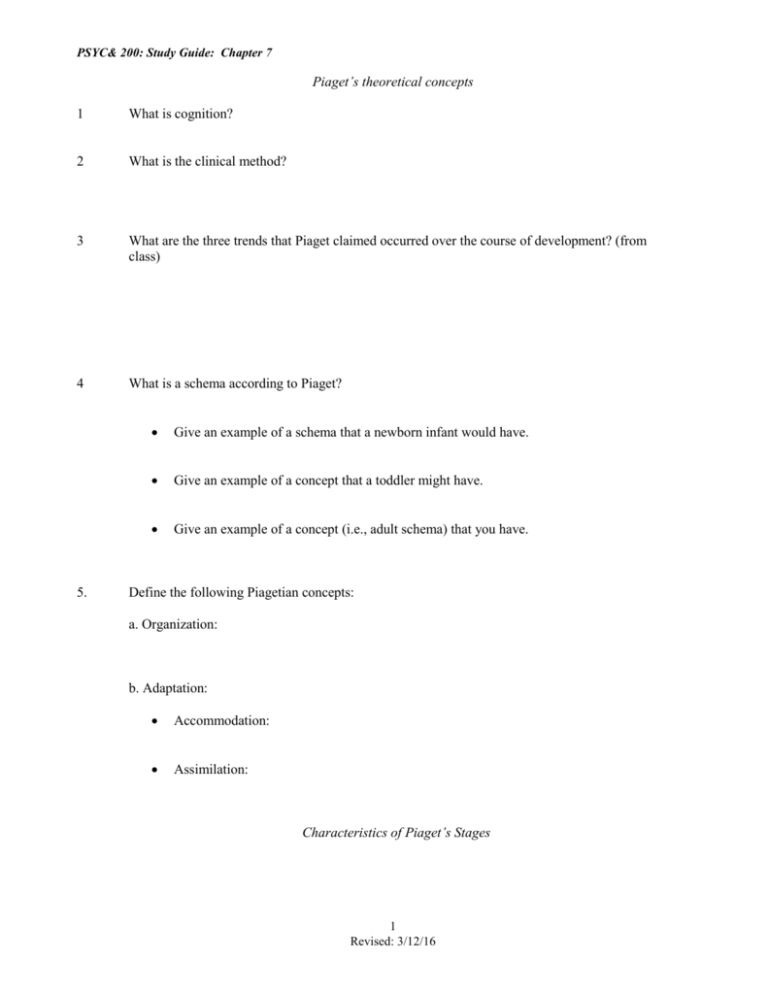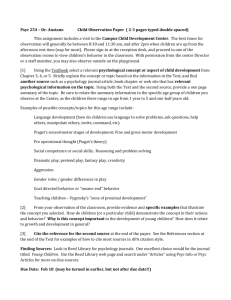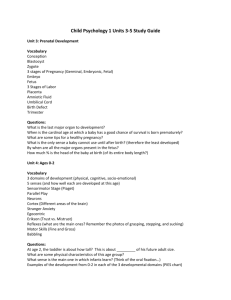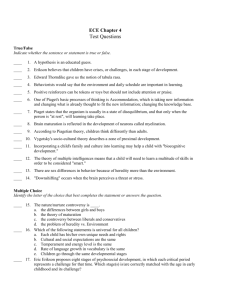Chapters 7 (MS
advertisement

PSYC& 200: Study Guide: Chapter 7 Piaget’s theoretical concepts 1 What is cognition? 2 What is the clinical method? 3 What are the three trends that Piaget claimed occurred over the course of development? (from class) 4 What is a schema according to Piaget? 5. Give an example of a schema that a newborn infant would have. Give an example of a concept that a toddler might have. Give an example of a concept (i.e., adult schema) that you have. Define the following Piagetian concepts: a. Organization: b. Adaptation: Accommodation: Assimilation: Characteristics of Piaget’s Stages 1 Revised: 3/12/16 PSYC& 200: Study Guide: Chapter 7 6 Describe the six substages of Piaget’s Sensorimotor Stage. Name of stage Rough age range Characteristics of stage (include information from class) 7 Describe the development of “object permanence” in infants as a way to illustrate one of Piaget’s trends and stages. Include an explanation of the A-not-B error in your answer. 8 What does the term “salient” mean? How is it relevant to preoperational children? 2 Revised: 3/12/16 PSYC& 200: Study Guide: Chapter 7 9 Describe preschoolers’ tendency for centration. Give an example, preferably one of your own, to illustrate the concept. 10. What is meant by “conservation” in the context of development? 11 What did Gelman’s research and Field’s research tell us about conservation in preschoolers? (from class) 12 To what does egocentrism refer? How is it expressed in preschool children? Give examples. 13 Describe other challenges of preoperational children (e.g., classification, animism, transductive reasoning, causality, appearance/reality distinction). 3 Revised: 3/12/16 PSYC& 200: Study Guide: Chapter 7 14 What did Piaget mean by “concrete operational” thinking? How do school age children differ from their preschool counterparts? 15 What did Piaget mean by “formal operational thinking”? What are the significant changes in children in this stage? How do people who engage in formal operational thinking differ from their school-aged counterparts? 16 Despite the significant advances in thinking, adolescents continue to show evidence of egocentrism. Describe how it manifests itself. 17 How does “post-formal” thought differ from the thinking in Piaget’s Formal Operational Stage? 4 Revised: 3/12/16 PSYC& 200: Study Guide: Chapter 7 18 a. How does the thinking of aging adults differ from their younger counterparts? b. What factors might account for these differences? 19 Why is Vygotsky’s theory called a “sociocultural” perspective? 20 Identify the following concepts of Vygotsky’s Sociocultural Theory of cognitive development: Zone of proximal development: Guided participation/scaffolding: 21 What is egocentric speech? Describe the difference between Vygotsky’s and Piaget’s view of egocentric speech. 5 Revised: 3/12/16 PSYC& 200: Study Guide: Chapter 7 22 Provide an evaluation of Vygotksy’s theory. What are the strengths of the theory? What are the limitations/weaknesses of the theory? 23 *What are some ways that infants communicate prior to producing their first words? 24 *What evidence is there of turn-taking between child and caregiver before children talk? 25 Describe Oller's five stages of prespeech development. 26 *What kinds of words do children learn first? 27 *What is meant by overextension? Underextension? Provide a clear example of each. 6 Revised: 3/12/16 PSYC& 200: Study Guide: Chapter 7 28 *Cite the problems young children have with verb conjugation and rules for pluralization. 29 Using notes from class and film, describe the characteristics of infant-directed speech? What other terms do researchers use to refer to this pattern of speech? (long answer) 30 *Using the text, and notes from class and the film, describe many ways that parents facilitate language development. (long answer) 31 Describe some typical characteristics of changes in communication skills of elderly people? 32 Due to high rates of strokes in elderly people, aphasia is relatively common. a) What is aphasia? b) Distinguish between expressive and receptive aphasia. What parts of the brain are associated with each type of aphasia? 33 What aspects of communication are affected by aphasia? 34 What kinds of things can people do to maximize communication with elderly folks? 7 Revised: 3/12/16 PSYC& 200: Study Guide: Chapter 7 8 Revised: 3/12/16





